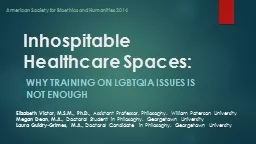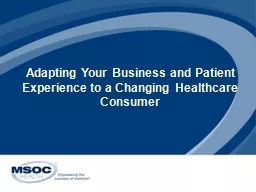PPT-Inhospitable Healthcare Spaces
Author : marina-yarberry | Published Date : 2016-05-05
Why Training on LGBTQIA Issues Is Not Enough Elizabeth Victor MSM PhD Assistant Professor Philosophy William Paterson University Megan Dean MA Doctoral Student
Presentation Embed Code
Download Presentation
Download Presentation The PPT/PDF document "Inhospitable Healthcare Spaces" is the property of its rightful owner. Permission is granted to download and print the materials on this website for personal, non-commercial use only, and to display it on your personal computer provided you do not modify the materials and that you retain all copyright notices contained in the materials. By downloading content from our website, you accept the terms of this agreement.
Inhospitable Healthcare Spaces: Transcript
Download Rules Of Document
"Inhospitable Healthcare Spaces"The content belongs to its owner. You may download and print it for personal use, without modification, and keep all copyright notices. By downloading, you agree to these terms.
Related Documents














